PORSCHE 911 GT3 2010 5.G User Guide
Manufacturer: PORSCHE, Model Year: 2010, Model line: 911 GT3, Model: PORSCHE 911 GT3 2010 5.GPages: 251, PDF Size: 14.33 MB
Page 11 of 251
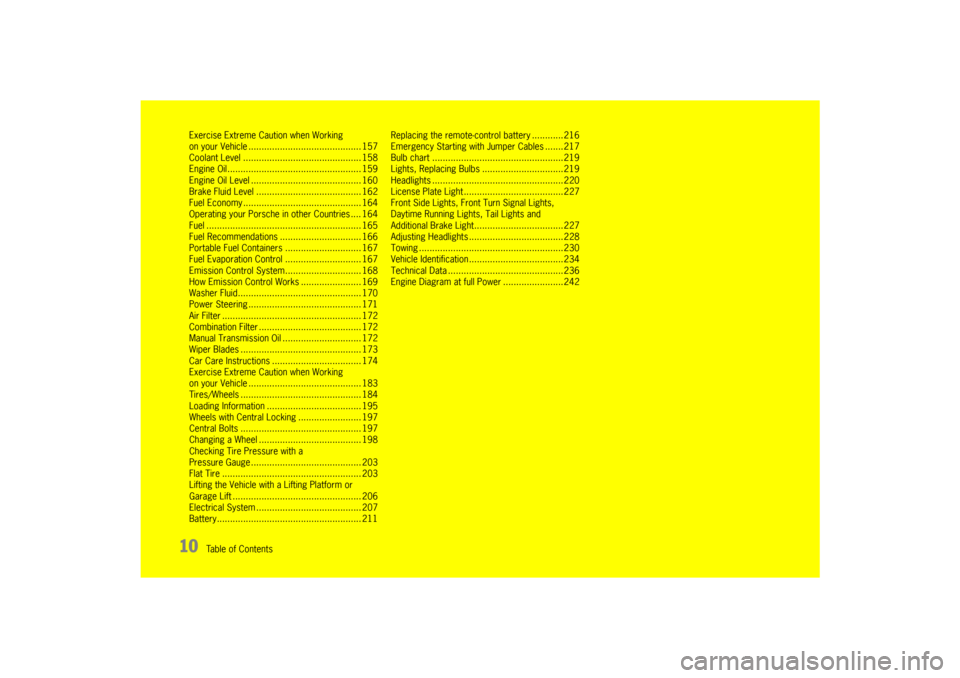
10
Table of Contents Exercise Extreme Caution when Working
on your Vehicle ........................................... 157
Coolant Level ............................................. 158
Engine Oil................................................... 159
Engine Oil Level .......................................... 160
Brake Fluid Level ........................................ 162
Fuel Economy ............................................. 164
Operating your Porsche in other Countries .... 164
Fuel ........................................................... 165
Fuel Recommendations............................... 166
Portable Fuel Containers ............................. 167
Fuel Evaporation Control ............................. 167
Emission Control System............................. 168
How Emission Control Works ....................... 169
Washer Fluid............................................... 170
Power Steering ........................................... 171
Air Filter ..................................................... 172
Combination Filter ....................................... 172
Manual Transmission Oil .............................. 172
Wiper Blades .............................................. 173
Car Care Instructions.................................. 174
Exercise Extreme Caution when Working
on your Vehicle ........................................... 183
Tires/Wheels .............................................. 184
Loading Information .................................... 195
Wheels with Central Locking ........................ 197
Central Bolts .............................................. 197
Changing a Wheel ....................................... 198
Checking Tire Pressure with a
Pressure Gauge .......................................... 203
Flat Tire ..................................................... 203
Lifting the Vehicle with a Lifting Platform or
Garage Lift ................................................. 206
Electrical System ........................................ 207
Battery....................................................... 211Replacing the remote-control battery ............216
Emergency Starting with Jumper Cables .......217
Bulb chart ..................................................219
Lights, Replacing Bulbs ...............................219
Headlights ..................................................220
License Plate Light ......................................227
Front Side Lights, Front Turn Signal Lights,
Daytime Running Lights, Tail Lights and
Additional Brake Light..................................227
Adjusting Headlights ....................................228
Towing .......................................................230
Vehicle Identification....................................234
Technical Data ............................................236
Engine Diagram at full Power .......................242
10_GT3_21.book Seite 10 Donnerstag, 4. Juni 2009 12:48 12
Page 12 of 251

Before driving off...
11
Dear Porsche Owner A lot has gone into the manufacture of your
Porsche, including advanced engineering, rigid
quality control and demanding inspections.
These engineering and safety features will be
enhanced by you... the safe driver... – who knows his/her car and all controls,
– who maintains the vehicle properly,
– who uses driving skills wisely and always
drives within her/his own capabilities and the
level of familiarity with the vehicle.
You will find helpful hints in this manual on how to
perform most of the checks listed on the following
pages.
If in doubt, have these checks performed by your
authorized Porsche dealer.
Before driving off... Check the following items first fTurn the engine off before you attempt any
checks or repairs on the vehicle.
fBe sure the tires are inflated correctly.
Check tires for damage and tire wear.
fSee that wheel bolts are properly tightened
and not loose or missing.
fCheck engine oil level, add if necessary.
Make it a habit to have engine oil checked with
every refueling.
fCheck all fluid levels such as windshield
washer and brake fluid levels.
fBe sure the vehicle battery is well charged and
cranks the engine properly.
fCheck all doors and lids for proper operation
and latch them properly.
fCheck, and if necessary replace worn or
cracked wiper blades.
fSee that all windows are clear and
unobstructed.
fCheck air intake slots and area between
luggage compartment lid and windshield.
Ensure that these areas are free of snow and
ice, so the heater and the windshield wipers
work properly. fIf a child will be riding in the vehicle, check
child seat/child seat restraint system to ensure
that restraints are properly adjusted.
fChild restraint systems will not fit into the
Sports bucket seat.
Do not install a child restraint system in the
Sports bucket seat.
The Sports bucket seat cannot be equipped
with the LATCH system and thus the airbag
system cannot be manually deactivated.
fCheck all exterior and interior lights for opera-
tion and that the lenses are clean.
fCheck the headlights for proper aim, and if
necessary, have them adjusted.
fCheck under the vehicle for leaks.
fBe sure all luggage is stowed securely.
Emergency equipment It is good practice to carry emergency equipment
in your vehicle.
Some of the items you should have are:
window scraper, snow brush, container or bag of
sand or salt, emergency light, small shovel, first-
aid kit, etc.
10_GT3_21.book Seite 11 Donnerstag, 4. Juni 2009 12:48 12
Page 13 of 251

12
Before driving off...
In the driver’s seat... fCheck operation of the horn.
fPosition seat for easy reach of foot pedals and
controls.
To reduce the possibility of injury from the
airbag deployment, you should always sit back
as far from the steering wheel as is practical,
while still maintaining full vehicle control.
fAdjust the inside and outside rear view mirrors.
fBuckle your safety belts.
fCheck operation of the foot and parking brake.
fCheck all warning and indicator lights with
ignition on and engine not running.
fStart engine and check all warning displays for
warning symbols.
fNever leave an idling car unattended.
fLock doors from inside, especially with
children in the car to prevent inadvertent
opening of doors from inside or outside.
Drive with doors locked.
On the road... fNever drive after you have consumed alcohol
or drugs.
fAlways have your safety belt fastened.
fAlways drive defensively.
Expect the unexpected.
fUse signals to indicate turns and lane changes.
fTurn on headlights at dusk or when the driving
conditions warrant it.
fAlways keep a safe distance from the vehicle in
front of you, depending on traffic, road and
weather conditions.
fReduce speed at night and during inclement
weather.
Driving in wet weather requires caution and
reduced speeds, particularly on roads with
standing water, as the handling characteristics
of the vehicle may be impaired due to hydropla-
ning of the tires.
fAlways observe speed limits and obey road
signs and traffic laws.
fWhen tired, get well off the road, stop and take
a rest. Turn the engine off. Do not sit in the
vehicle with engine idling.
Please see the chapter “ENGINE EXHAUST” on
Page 8.fWhen parked, always set the parking brake.
Move the gearshift lever to reverse or first
gear.
On hills also turn the front wheels toward the
curb.
fWhen emergency repairs become necessary,
move the vehicle well off the road. Turn on the
emergency flasher and use other warning
devices to alert other motorists. Do not park
or operate the vehicle in areas where the hot
exhaust system may come in contact with dry
grass, brush, fuel spill or other flammable
material.
fMake it a habit to have the engine oil checked
after every refueling.
10_GT3_21.book Seite 12 Donnerstag, 4. Juni 2009 12:48 12
Page 14 of 251

Before driving off...
13
Break in hints for the first
2,000 miles/3,000 kilometers The following tips will be helpful in obtaining
optimum performance from your new Porsche.
Despite the most modern, high-precision manufac-
turing methods, the moving parts must still wear
in with each other. This wearing-in occurs mainly in
the first 2,000 miles/3,000 kilometers.Therefore: fPreferably take longer trips.
fAvoid frequent cold starts with short-distance
driving whenever possible.
fAvoid full throttle starts and abrupt stops.
fDo not exceed maximum engine speed of
4,200 rpm (revolutions per minute).
fDo not run a cold engine at high rpm either in
Neutral or in gear.
fDo not let the engine labor, especially when
driving uphill. Shift to the next lower gear in
time (use the most favorable rpm range).
fNever lug the engine in high gear at low
speeds. This rule applies at all times, not just
during the break-in period.fDo not participate in motor racing events,
sports driving schools, etc. during the first
2,000 miles/3,000 kilometers.
There may be a slight stiffness in the steering,
gear-shifting or other controls during the break-in
period which will gradually disappear.
Break in brake pads and brake discsNew brake pads and discs have to be “broken in”,
and therefore only attain optimal friction when the
car has covered several hundred miles or km.
The slightly reduced braking ability must be
compensated for by pressing the brake pedal
harder. This also applies whenever the brake pads
and brake discs are replaced.
A significant amount of brake noise may be heard
during the break-in period.New tires New tires do not have maximum traction. They
tend to be slippery.
fBreak in new tires by driving at moderate
speeds during the first 60 to 120 miles/100 to
200 km. Longer braking distances must be
anticipated.
Engine oil and fuel consumption During the break-in period oil and fuel consump-
tion may be higher than normal.
fPlease see the chapter “TECHNICAL DATA” on
Page 236.
As always, the rate of oil consumption depends on
the quality and viscosity of oil, the speed at which
the engine is operated, the climate and road
conditions, as well as the amount of dilution and
oxidation of the lubricant.
fMake a habit of checking engine oil with every
refueling, add if necessary.
10_GT3_21.book Seite 13 Donnerstag, 4. Juni 2009 12:48 12
Page 15 of 251
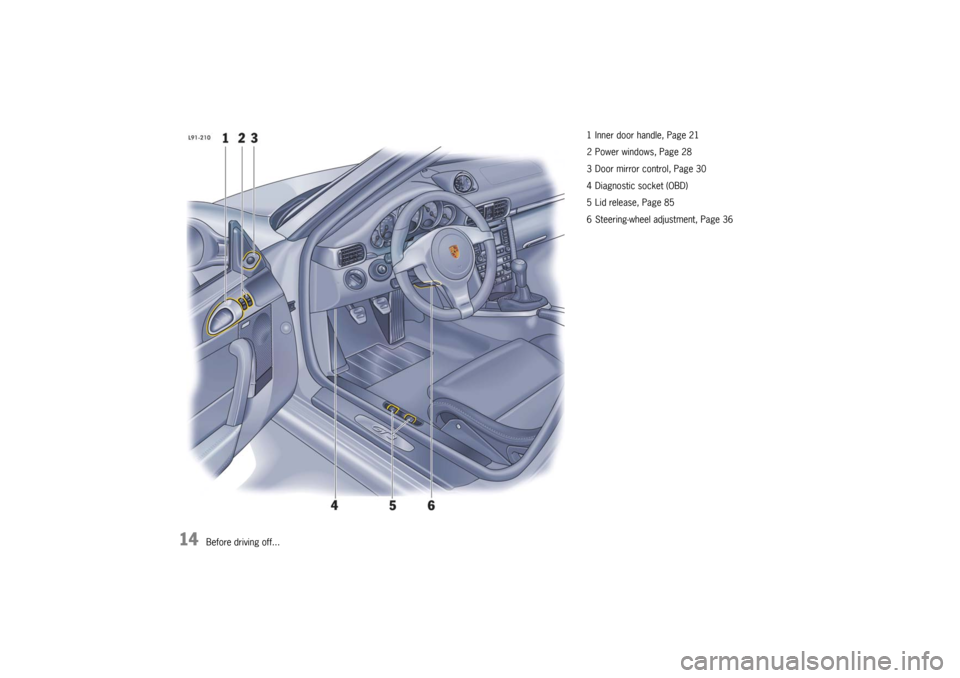
14
Before driving off...1 Inner door handle, Page 21
2 Power windows, Page 28
3 Door mirror control, Page 30
4 Diagnostic socket (OBD)
5 Lid release, Page 85
6 Steering-wheel adjustment, Page 36
10_GT3_21.book Seite 14 Donnerstag, 4. Juni 2009 12:48 12
Page 16 of 251
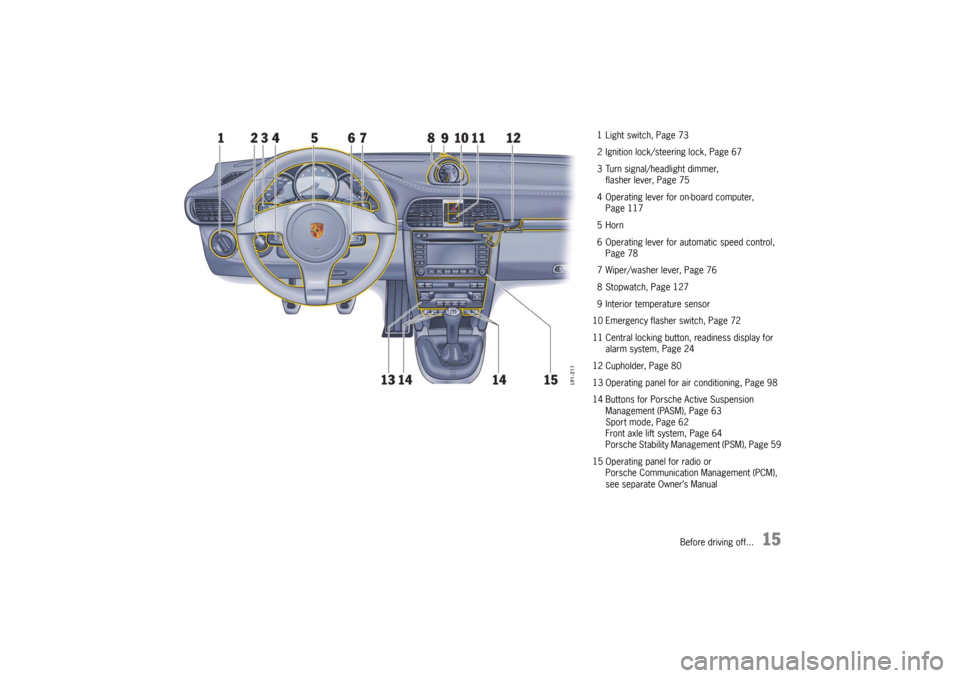
Before driving off...
15
1 Light switch, Page 73
2 Ignition lock/steering lock, Page 67
3 Turn signal/headlight dimmer,
flasher lever, Page 75
4 Operating lever for on-board computer,
Page 117
5Horn
6 Operating lever for automatic speed control,
Page 78
7 Wiper/washer lever, Page 76
8 Stopwatch, Page 127
9 Interior temperature sensor
10 Emergency flasher switch, Page 72
11 Central locking button, readiness display for
alarm system, Page 24
12 Cupholder, Page 80
13 Operating panel for air conditioning, Page 98
14 Buttons for Porsche Active Suspension
Management (PASM), Page 63
Sport mode, Page 62
Front axle lift system, Page 64
Porsche Stability Management (PSM), Page 59
15 Operating panel for radio or
Porsche Communication Management (PCM),
see separate Owner’s Manual
10_GT3_21.book Seite 15 Donnerstag, 4. Juni 2009 12:48 12
Page 17 of 251
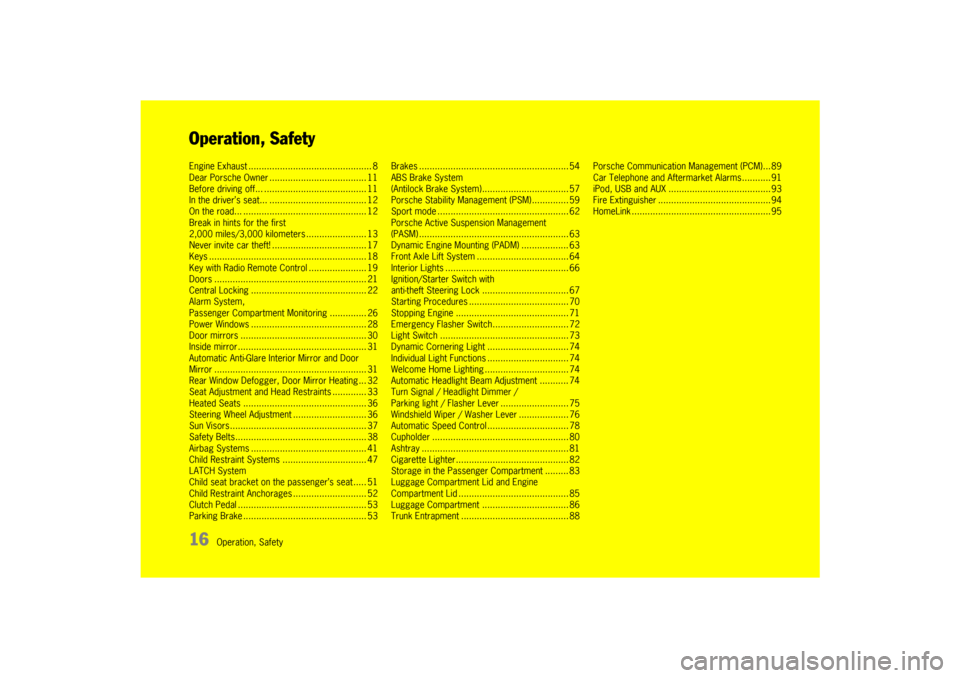
16
Operation, Safety
Operation, SafetyEngine Exhaust ............................................... 8
Dear Porsche Owner ..................................... 11
Before driving off... ....................................... 11
In the driver’s seat... ..................................... 12
On the road... ............................................... 12
Break in hints for the first
2,000 miles/3,000 kilometers ....................... 13
Never invite car theft! .................................... 17
Keys ............................................................ 18
Key with Radio Remote Control ...................... 19
Doors .......................................................... 21
Central Locking ............................................ 22
Alarm System,
Passenger Compartment Monitoring .............. 26
Power Windows ............................................ 28
Door mirrors ................................................ 30
Inside mirror ................................................. 31
Automatic Anti-Glare Interior Mirror and Door
Mirror .......................................................... 31
Rear Window Defogger, Door Mirror Heating ... 32
Seat Adjustment and Head Restraints ............. 33
Heated Seats ............................................... 36
Steering Wheel Adjustment ............................ 36
Sun Visors.................................................... 37
Safety Belts.................................................. 38
Airbag Systems ............................................ 41
Child Restraint Systems ................................ 47
LATCH System
Child seat bracket on the passenger’s seat ..... 51
Child Restraint Anchorages ............................ 52
Clutch Pedal ................................................. 53
Parking Brake ............................................... 53Brakes ......................................................... 54
ABS Brake System
(Antilock Brake System)................................. 57
Porsche Stability Management (PSM).............. 59
Sport mode .................................................. 62
Porsche Active Suspension Management
(PASM) ......................................................... 63
Dynamic Engine Mounting (PADM) .................. 63
Front Axle Lift System ................................... 64
Interior Lights ............................................... 66
Ignition/Starter Switch with
anti-theft Steering Lock ................................. 67
Starting Procedures ...................................... 70
Stopping Engine ........................................... 71
Emergency Flasher Switch............................. 72
Light Switch ................................................. 73
Dynamic Cornering Light ............................... 74
Individual Light Functions ............................... 74
Welcome Home Lighting ................................ 74
Automatic Headlight Beam Adjustment ........... 74
Turn Signal / Headlight Dimmer /
Parking light / Flasher Lever .......................... 75
Windshield Wiper / Washer Lever ................... 76
Automatic Speed Control ............................... 78
Cupholder .................................................... 80
Ashtray ........................................................ 81
Cigarette Lighter........................................... 82
Storage in the Passenger Compartment ......... 83
Luggage Compartment Lid and Engine
Compartment Lid .......................................... 85
Luggage Compartment ................................. 86
Trunk Entrapment ......................................... 88Porsche Communication Management (PCM)... 89
Car Telephone and Aftermarket Alarms........... 91
iPod, USB and AUX ....................................... 93
Fire Extinguisher ........................................... 94
HomeLink ..................................................... 95
10_GT3_21.book Seite 16 Donnerstag, 4. Juni 2009 12:48 12
Page 18 of 251

Operation, Safety
17
Never invite car theft! An unlocked car with the key in the ignition lock
invites car theft.
A steering wheel lock and a gong alarm are
standard equipment in your Porsche.
The gong alarm will sound if you open the driver’s
door while the key is still in the ignition lock. It is
your reminder to pull the key out of the ignition
lock and to lock the doors.
Warning!
Any uncontrolled movement of the vehicle
may result in property damage, serious
personal injury or death.
Never leave your vehicle unattended with the
key in the ignition lock, especially if children
and/or pets are left unattended in the
vehicle. They can operate power windows
and other controls. If the engine is left
running, they may accidentally engage the
shift lever. Serious personal injury or death
could result from loss of control of the
vehicle.
fAlways remove the ignition key.
fAlways set the parking brake.
fLock the doors with the remote control.
Warning!
Risk of a serious accident.
The steering column will lock when you
remove the key while you are driving or as
the car is rolling to a stop. You will not be
able to steer the car.
Serious personal injury or death could result
from loss of control of the vehicle.
fNever remove the key from the steering lock while you are driving. To protect your vehicle and your possessions
from theft, you should always proceed as
follows when leaving your vehicle:
fClose windows.
fRemove ignition key.
fEngage steering lock.
fLock glove compartment.
fRemove valuables (e.g. car documents, cell
phones, house keys) from the car.
fLock doors.
10_GT3_21.book Seite 17 Donnerstag, 4. Juni 2009 12:48 12
Page 19 of 251

18
Operation, Safety
Keys fPlease see the chapter “ALARM SYSTEM,
PASSENGER COMPARTMENT MONITORING”
on Page 26.
fPlease see the chapter “CENTRAL LOCKING”
on Page 22.
Two car keys are supplied with your Porsche.
These keys operate all the locks on your vehicle.
fBe careful with your car keys: do not part with
them except under exceptional circumstances.
fTo avoid battery run-down, always remove the
ignition key from the ignition lock. Emergency operationfPlease see the chapter “EMERGENCY OPERA-
TION – PULLING OUT THE IGNITION KEY” on
Page 69.
Replacement keys Replacement car keys can be obtained only from
your authorized Porsche dealer, and this can
sometimes be very time-consuming.
You should therefore always keep a spare key on
your person.
Keep it in a safe place (e.g. wallet), but under no
circumstances in or on the vehicle.
The key codes of new keys have to be “reported”
to the car control unit by your authorized Porsche
dealer.
A total of 6 car keys can be reported to the control
unit.
Disabling key codes
If a key is lost, the key codes can be disabled by
an authorized Porsche dealer.
All the remaining car keys are required for this
purpose.
Disabling the code ensures that the car can be
started only using authorized keys.
Note
fPlease note that the other locks can still be
opened with the disabled key.
Immobilizer There is a transponder (an electronic component)
in the key grip, containing a stored code.
When the ignition is switched on, the ignition lock
checks the code.
The immobilizer can be deactivated and the
engine started only using an authorized ignition
key.
Switching off the immobilizer
fInsert the ignition key into the ignition lock.
If the ignition is left on for more than 2 minutes
without the engine being started, the immobilizer
is switched on again.
fIf this happens, turn the ignition key back to
position 3 (ignition off) before starting the
engine. The immobilizer is deactivated again,
and the engine can be started.
fPlease see the chapter “IGNITION/STARTER
SWITCH WITH ANTI-THEFT STEERING LOCK”
on Page 67.
Switching on the immobilizer
fRemove ignition key.
10_GT3_21.book Seite 18 Donnerstag, 4. Juni 2009 12:48 12
Page 20 of 251
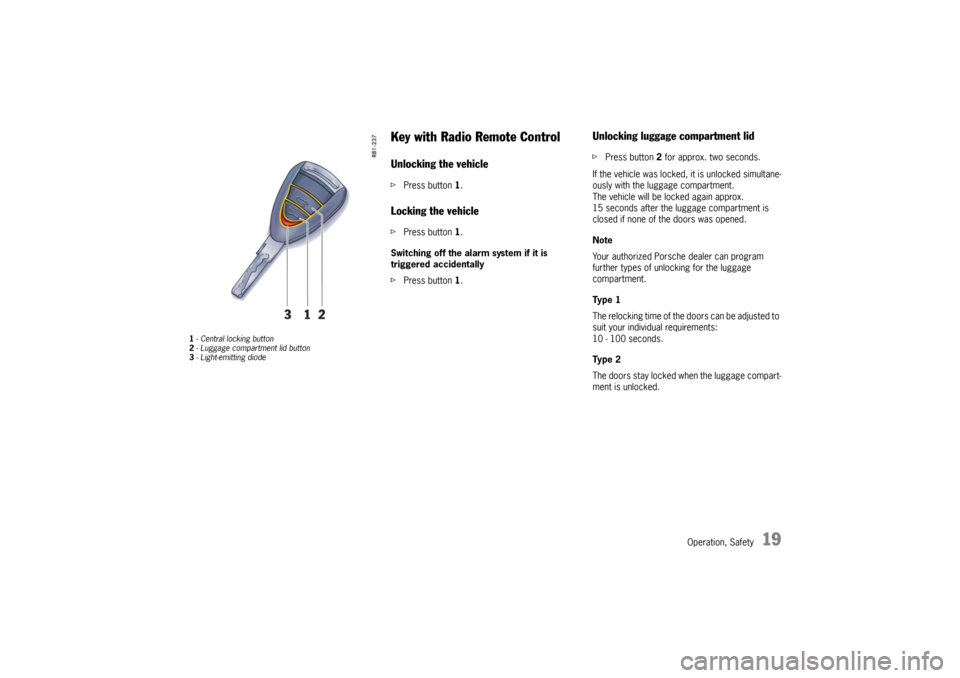
Operation, Safety
19
1- Central locking button
2- Luggage compartment lid button
3- Light-emitting diode
Key with Radio Remote Control Unlocking the vehiclefPress button 1.Locking the vehiclefPress button 1.
Switching off the alarm system if it is
triggered accidentally
fPress button 1.
Unlocking luggage compartment lidfPress button 2 for approx. two seconds.
If the vehicle was locked, it is unlocked simultane-
ously with the luggage compartment.
The vehicle will be locked again approx.
15 seconds after the luggage compartment is
closed if none of the doors was opened.
Note
Your authorized Porsche dealer can program
further types of unlocking for the luggage
compartment.
Ty p e 1
The relocking time of the doors can be adjusted to
suit your individual requirements:
10 - 100 seconds.
Ty p e 2
The doors stay locked when the luggage compart-
ment is unlocked.
10_GT3_21.book Seite 19 Donnerstag, 4. Juni 2009 12:48 12